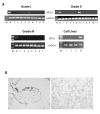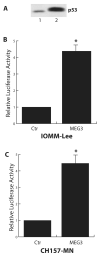Maternally expressed gene 3, an imprinted noncoding RNA gene, is associated with meningioma pathogenesis and progression
- PMID: 20179190
- PMCID: PMC2987571
- DOI: 10.1158/0008-5472.CAN-09-3885
Maternally expressed gene 3, an imprinted noncoding RNA gene, is associated with meningioma pathogenesis and progression
Abstract
Meningiomas are common tumors, representing 15% to 25% of all central nervous system tumors. NF2 gene inactivation on chromosome 22 has been shown as an early event in tumorigenesis; however, few factors underlying tumor growth and progression have been identified. The chromosomal abnormalities of 14q32 are often associated with meningioma pathogenesis and progression; therefore, it has been proposed that an as yet unidentified tumor suppressor is present at this locus. Maternally expressed gene 3 (MEG3) is an imprinted gene located at 14q32 which encodes a noncoding RNA with an antiproliferative function. We found that MEG3 mRNA is highly expressed in normal arachnoidal cells. However, MEG3 is not expressed in the majority of human meningiomas or the human meningioma cell lines IOMM-Lee and CH157-MN. There is a strong association between loss of MEG3 expression and tumor grade. Allelic loss at the MEG3 locus is also observed in meningiomas, with increasing prevalence in higher grade tumors. In addition, there is an increase in CpG methylation within the promoter and the imprinting control region of MEG3 gene in meningiomas. Functionally, MEG3 suppresses DNA synthesis in both IOMM-Lee and CH157-MN cells by approximately 60% in bromodeoxyuridine incorporation assays. Colony-forming efficiency assays show that MEG3 inhibits colony formation in CH157-MN cells by approximately 80%. Furthermore, MEG3 stimulates p53-mediated transactivation in these cell lines. Therefore, these data are consistent with the hypothesis that MEG3, which encodes a noncoding RNA, may be a tumor suppressor gene at chromosome 14q32 involved in meningioma progression via a novel mechanism.
Figures




References
-
- Louis OHDN, Wiestler OD, Cavenee WK. World Health Organization Classification of Tumours of the Central Nervous System. IARC Press; Lyon: 2007.
-
- Lusis E, Gutmann DH. Meningioma: an update. Curr Opin Neurol. 2004;17(6):687–92. - PubMed
-
- Simon M, von Deimling A, Larson JJ, et al. Allelic losses on chromosomes 14, 10, and 1 in atypical and malignant meningiomas: a genetic model of meningioma progression. Cancer Res. 1995;55(20):4696–701. - PubMed
-
- Menon AG, Rutter JL, von Sattel JP, et al. Frequent loss of chromosome 14 in atypical and malignant meningioma: identification of a putative ‘tumor progression’ locus. Oncogene. 1997;14(5):611–6. - PubMed
Publication types
MeSH terms
Substances
Grants and funding
LinkOut - more resources
Full Text Sources
Molecular Biology Databases
Research Materials
Miscellaneous

